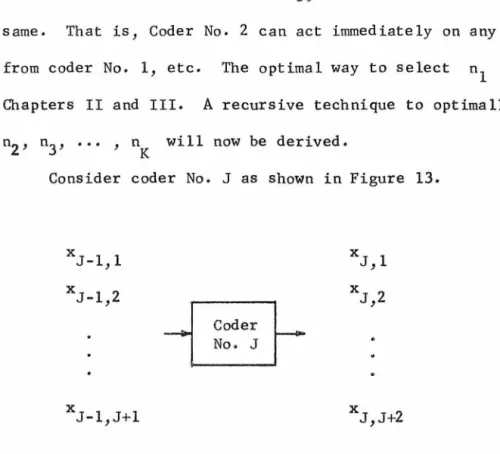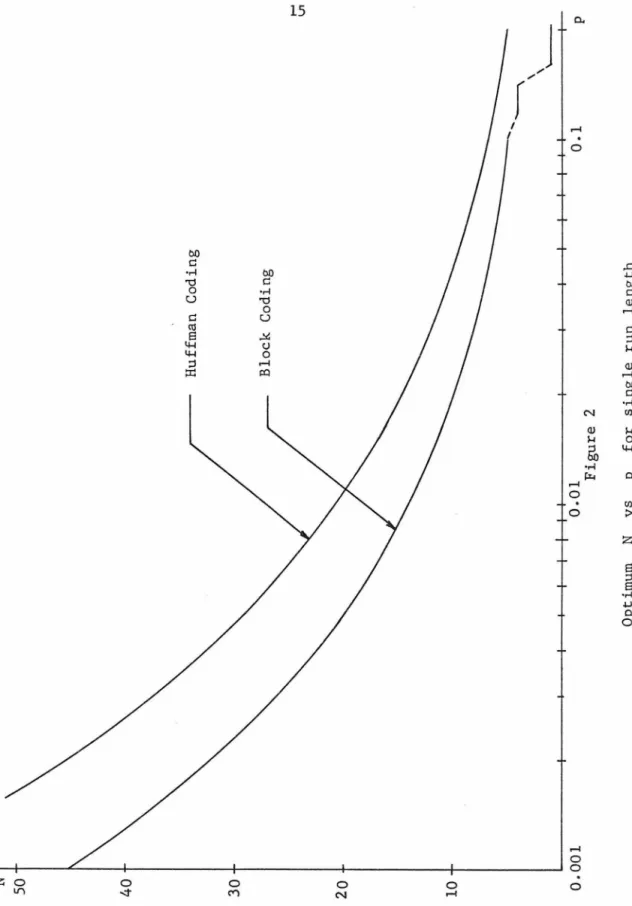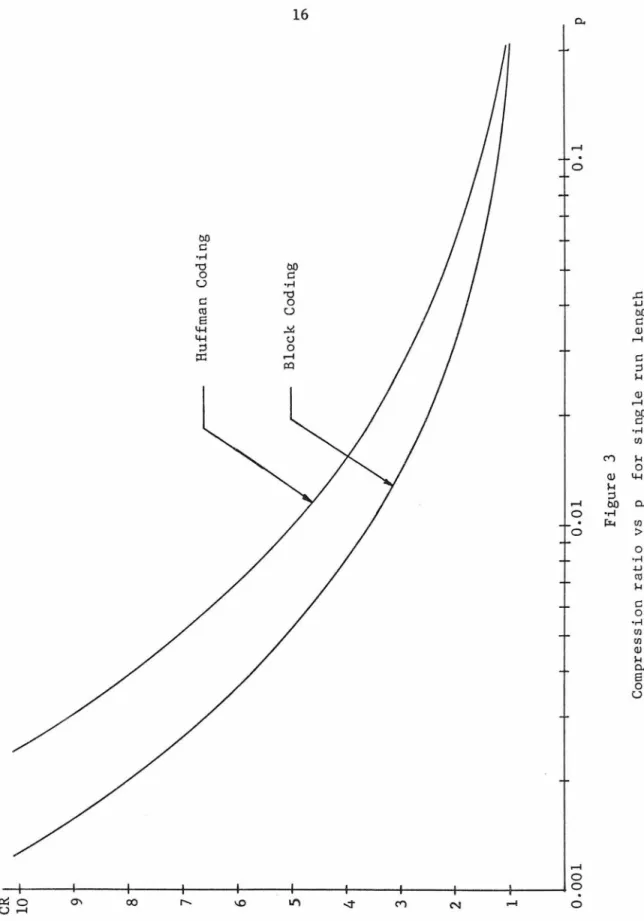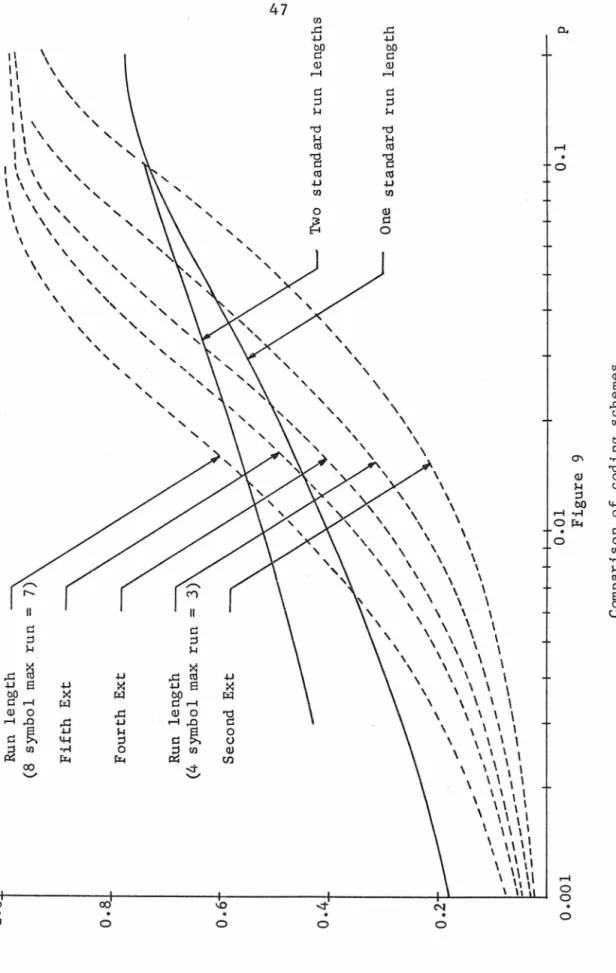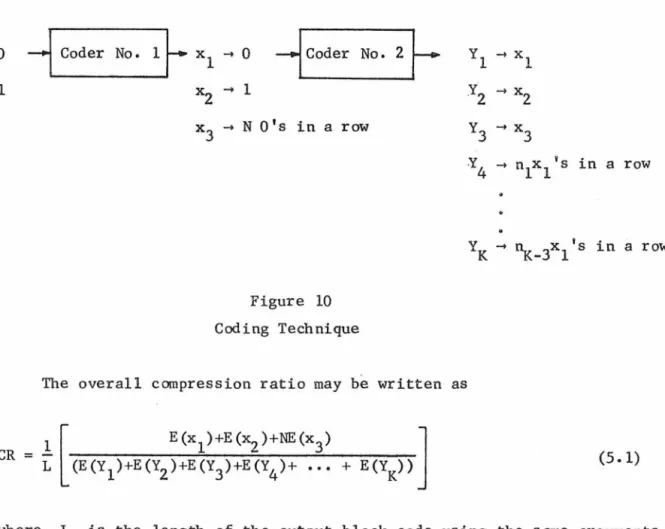The optimality criterion chosen for this thesis is the maximization of the compression ratio. The compression ratio is defined as the expected ratio of the number of binary digits in the input sequence to the number of binary digits in the output sequence as the length of the j 11;>ut sequence tends to infinity. The mapping of one of the above input sequences into the corresponding output sequence will be denoted as an encoder action (CA).
The compression ratio (CR) is defined in Chapter I to be the expected ratio of the number of binary digits in the input sequence to the number of binary digits in the output sequence as the length of the input sequence tends to infinity. The results of the computer search are given in Table 2 and plotted in Figures 2 and 3. A comparison of the efficiency of this scheme with various other coding schemes is given in Figure 9 at the end of.
For this reason the analysis of the independent. the source is given separately in Chapter II. 3, no input symbols are stored and the source is in state 0 at the end of the encoder operation. Referring to Figures 4 and 5 and using the reasoning of Section 3.2, the probabilities of the possible encoder actions conditional on the previous encoder action can be defined as follows.
1 first-order binary Markov sources are chosen to be p and q, respectively, the Markov source is equivalent to an independent binary source with probabilities p and q for a 1 and 0, respectively. The encoder is assumed to have a memory of N binary digits, where N is the length of the longest standard string lengths. There is a strong suspicion that computer search results are global optima, although this has not been proven.
The compression ratio is defined as the expected ratio between the number of binary digits in the input string and the number of binary digits in the output string, since the length of the input string tends to infinity. It is strongly suspected that the results of the computer search are global optimizations, although this has not been proven. The results of Figure 9 hold for Huffman encoding of the output symbols in each case.
The encoder was limited to a memory of N binary digits, where N is the length of the longest standard string length. An encoding algorithm is defined to encode an input string using the maximum number of the longest standard string lengths, followed by the maximum number of the next longest standard strings, and so on. This is because the required output symbol block code length increases faster. as a compression ratio.
Again, the string is assumed to be encoded using the largest number of the longest standard string length, followed by the largest number of the next longest string, and so on.

The symbol compression ratio for each encoder is defined as the expected ratio of the number of symbols in the input sequence to the number of symbols in the output sequence as the length of the input sequence tends to infinity. Using the same reasoning as given in Sections 2.4 and 3.4, the symbol compression ratio for the Jth coder converges with probability one to. In Chapter II, the optimum single standard run length for the binary independent source was derived assuming that the output symbols are block coded.
The unblocked output code (Huffman) required a computer search to determine the optimal standard length. This chapter analyzes a simple encoding scheme using a single standard string length and a non-block output code. The globally optimal uniform standard sequence length was derived for the binary independent source and the globally optimal uniform standard sequence lengths of zeros and ones were derived for the first-order binary Markov source.
It is assumed that the output symbols are then block-encoded in each case. The optimal standard run lengths depend on whether block or Huffman coding is then used to encode the symbols. If Huffman coding is used on the output symbols, the standard optimal run lengths can be determined by a limited computational search.
For a binary independent source, a simple single standard string length scheme using a non-block code on the output symbols was also derived. The advantage of this scheme is over conventional string length encoding, resource extension encoding, or more general variable selection. From a theoretical point of view, for example, Huffman coding of a sufficiently large source spread will provide a performance that is close to the desired one.
Implementation of this scheme, however, requires the encoder to be able to distinguish between 2 n source sequences of length n, where n is the order of expansion. A comparison of the efficiency of different schemes as a function of source statistics is given in Figure 9. Thus, the choice of a particular coding scheme for data compression does not only depend on the achievable compression ratio.
